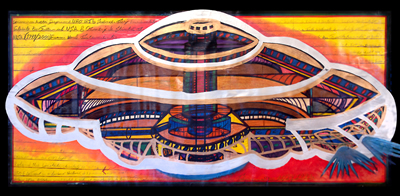In the first of this year’s Great Artists Series in the A.J. Fletcher Opera Theater, pianist Radu Lupu demonstrated why he is often called the gentle giant. If you were not there, you sure missed out.
The evening was dominated by music of Schubert. Sure, there was a Piano Sonata by Lupu’s Landsmann George Enescu, and even one by Beethoven, but Schubert dominated from the opening Impromptu D.899 No.1 in c minor to two of the three meaty encores.
The sight of Lupu playing recalls pictures of Johannes Brahms at the piano, leaning back in his chair, arms stretched out to reach the distant keyboard. You’d think this position would present an ergonomic disaster until you realize that Lupu plays mainly with his fingers, with little arm-much less back-action. Ergonomically incorrect or not, it works for him although his playing position caused the back of his chair to wobble annoyingly in the first half.
The opening Schubert Impromptu set the tone for the evening: gentle, meditative, every nuance extracted to its fullest. Lupu had his own singular concept of the work and he presented it with conviction, first performing the melody without expression, almost as a simple peasant’s song. Nearly every other pianist we know plays the three repeated notes of the theme with a crescendo. Lupu, instead, saved the emotion, building it slowly for the subsequent development of the melody.
Lupu extended this contemplative approach to Beethoven’s Piano Sonata in e, Op.90. Although this is perhaps the most “Schubertian” in mood of Beethoven’s sonatas, Lupu’s gentle approach worked less well-we have a hard time associating such mildness with Beethoven; somehow the Lebhaftigkeit (liveliness) that Beethoven specified in the first movement was missing.
Except for the two Romanian Rhapsodies, George Enescu is not a household name outside his native country. A man of divided loyalties, he spent a good part of his life studying and working in France. The themes of his Piano Sonata in F-sharp Op.24, No.1, composed in 1924, may have been inspired by Romanian folk melodies, but what he did with them is more Paris than Bucharest. Its four movements follow the standard tempi of the classical sonata, but the thematic development is complex and rhapsodic. It is an extremely difficult work to play and to follow. Although it was unfamiliar to the audience it generated a lot of enthusiasm. To our knowledge this Sonata is unavailable on recordings and we hope Lupu will rectify this omission.
Schubert composed his Piano Sonata in c minor, D.958, the first of three he finished just a few months before his death. As in the opening Impromptu, Lupu’s gentle approach and attention to textural details brought out its somber and tragic mood, especially in the first two movements. In the context of this exacting approach to the music, Lupu revealed the marvelous tension of the cross rhythms in the scherzo. The final movement, taken somewhat more slowly and less frenetically than is customary, fit smoothly into his interpretation of the work as a whole.
Despite the challenging program, Lupu responded to the audience’s enthusiasm with three encores, all of them of substantial length and emotional weight. For whatever reason, Lupu chose not to announce the titles of his encores, and the first two posed no problems for the musically literate. They were the Moments Musicaux D.780 No.1 in C and another Impromptu D.899 No.4 in A-flat, the latter the only example of fancy finger work in the entire program. Then came the mystery encore, which even the many professional pianists in the audience couldn’t recognize-even Mrs. Lupu, when asked, said she’d never heard it before. It certainly sounded like Debussy, but then so did many parts of the Enescu Sonata earlier in the program. Lupu later told David Worters that it was from an early Debussy “notebook.”
Taking this lead, we did some musical surfing to get the full scoop. The third encore, D’un cahier d’esquisses (“from a sketchbook”) by Claude Debussy, has an interesting history. Composed in 1903, it was apparently intended as part of a triptych, a new “Suite bergamasque” in three movements, the other parts being Masques and the famous L’isle joyeuse. It seems, however, that quarrels with his publishers prevented Debussy from ever publishing the suite as a whole, and D’un cahier d’esquisses remained half-forgotten. Only in 1995 were the three pieces finally reunited and published as a set.
Lupu’s meditative style of playing may relate to what appears to be a certain shyness before his audience. This is not a performer who plays up to his audience. In his austere way, however, he communicated his gratitude for his ovation with these three substantial extras.
The only fault we have to find in the whole evening was that absence of program notes. Surely a series of “greats” should not be skimping on its presentation.












